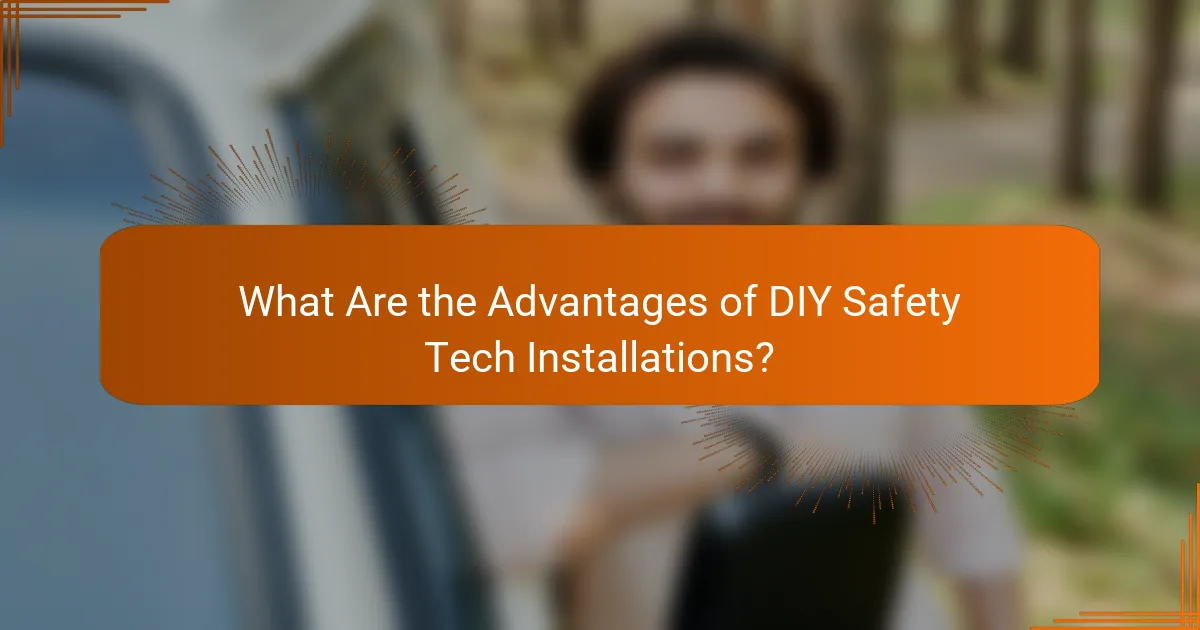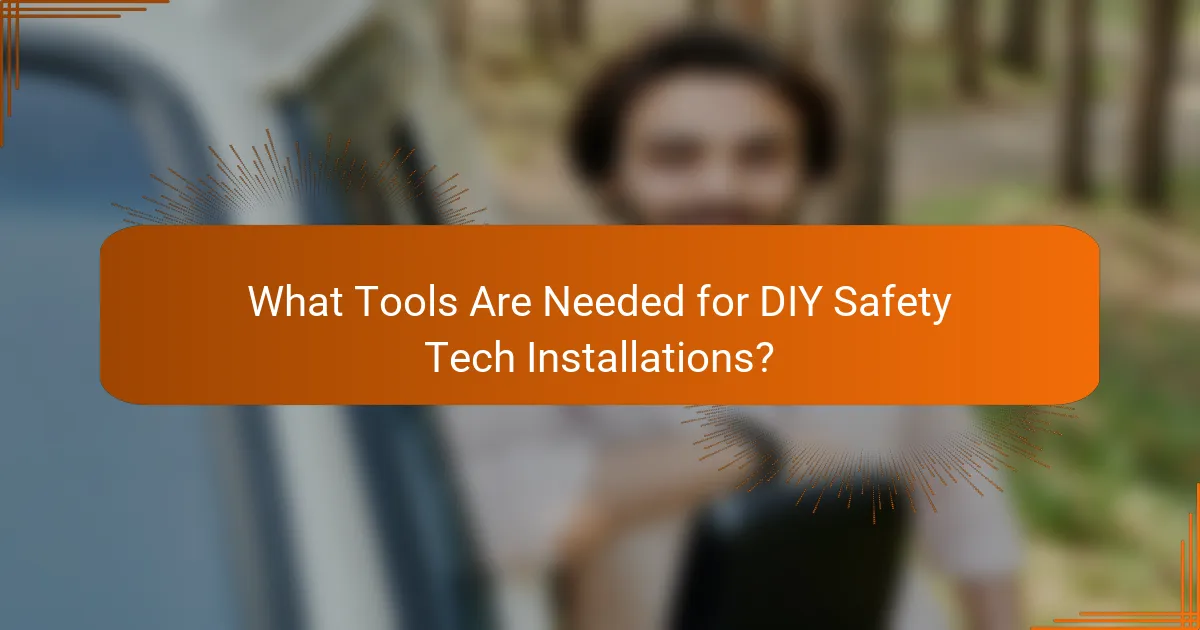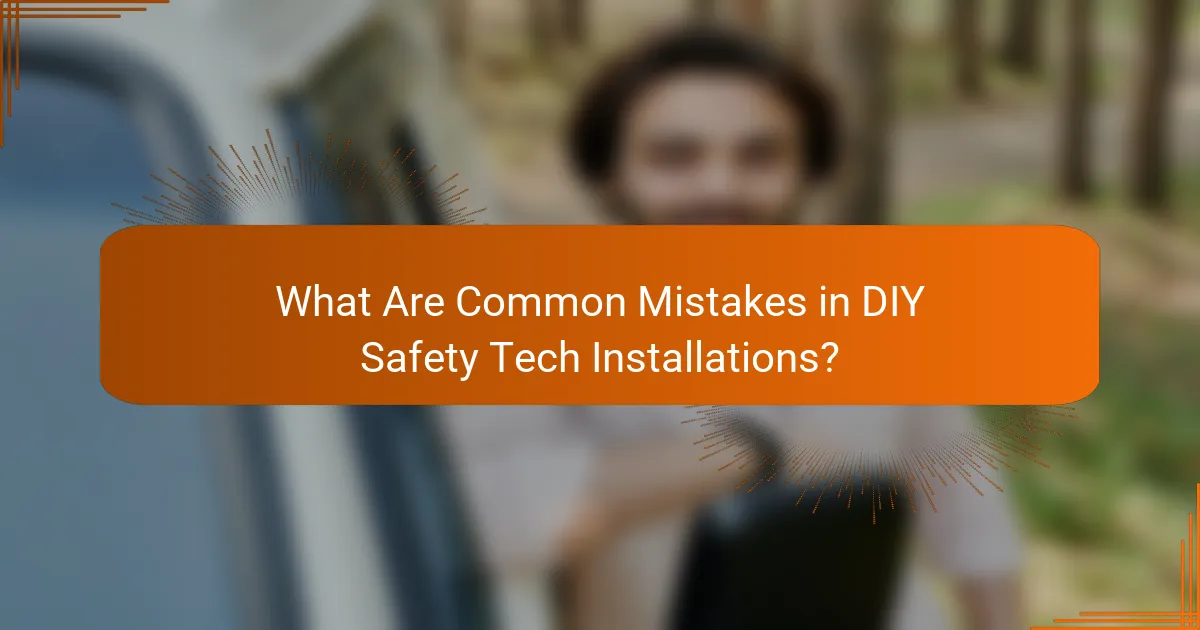When it comes to safety tech installations, homeowners often face the choice between DIY projects and hiring professionals. While DIY installations can save money and provide customization, professional help ensures compliance with regulations and expert installation. Evaluating your skills, the complexity of the system, and your budget is essential to making the right decision for your safety needs.

What Are the Benefits of Professional Safety Tech Installations?
Professional safety tech installations offer numerous advantages, including expert knowledge, compliance with regulations, and ongoing support. These benefits ensure that your safety systems are installed correctly, function optimally, and provide peace of mind.
Expertise and Experience
Professionals bring specialized knowledge and years of experience to safety tech installations. Their training allows them to navigate complex systems and troubleshoot potential issues effectively. This expertise can prevent costly mistakes that often occur with DIY installations.
For example, a professional installer can assess your specific needs and recommend the best equipment tailored to your environment, ensuring optimal performance and reliability.
Warranty and Support
Many professional installations come with warranties that cover both equipment and labor. This means that if something goes wrong, you have support to address the issue without incurring additional costs. In contrast, DIY installations typically do not offer such guarantees.
Having access to professional support can be invaluable, especially in emergencies where safety systems must function flawlessly. Knowing you have a reliable contact for assistance can provide significant peace of mind.
Compliance with Regulations
Professional installers are well-versed in local safety regulations and standards, ensuring that your systems meet all necessary legal requirements. Compliance is crucial, as failing to adhere to these regulations can lead to fines or increased liability in case of an incident.
For instance, in the U.S., safety installations must often comply with National Fire Protection Association (NFPA) standards. Professionals are equipped to ensure your installation meets these critical guidelines.
Time Efficiency
Hiring professionals for safety tech installations can save you considerable time. Experts can complete installations in a fraction of the time it might take an inexperienced individual, allowing you to focus on other important tasks.
Moreover, professionals are familiar with the tools and processes needed, which minimizes delays and ensures that the installation is done correctly the first time.
Quality Assurance
Professional installations typically guarantee a higher level of quality compared to DIY efforts. Installers use industry-standard techniques and high-quality materials, which enhance the longevity and reliability of your safety systems.
Additionally, many professionals conduct post-installation checks to ensure everything operates as intended, providing an extra layer of assurance that your safety technology will perform effectively when needed.

What Are the Advantages of DIY Safety Tech Installations?
DIY safety tech installations offer several benefits, including cost savings, greater flexibility, and the chance to learn new skills. By taking on the installation yourself, you can tailor the setup to your specific needs while potentially avoiding labor costs.
Cost Savings
One of the primary advantages of DIY safety tech installations is the potential for significant cost savings. Hiring a professional can often add hundreds to thousands of dollars to your project, depending on the complexity of the system. By doing it yourself, you can invest that money into higher-quality equipment or additional features.
For example, if a professional installation costs around $200 to $500, you can save that amount by opting for a DIY approach. Just be sure to budget for any tools or materials you might need, which can still keep your overall expenses low.
Flexibility and Control
DIY installations provide you with greater flexibility and control over the entire process. You can choose the equipment that best fits your needs, customize the layout, and adjust settings without waiting for a technician. This autonomy allows you to make changes on the fly, ensuring the system works optimally for your specific situation.
Additionally, you can schedule the installation at your convenience, avoiding the need to coordinate with a professional’s availability. This can be particularly useful for busy households or those with unpredictable schedules.
Learning Opportunity
Installing safety tech yourself can be a valuable learning experience. It allows you to understand how the systems work, which can be beneficial for troubleshooting in the future. Gaining hands-on experience with technology can also enhance your skills and confidence in handling similar projects down the line.
Consider starting with simpler devices, such as smart cameras or alarms, to build your knowledge before tackling more complex systems. There are many online resources and tutorials available to guide you through the process, making it easier to learn as you go.

How to Choose Between DIY and Professional Installations?
Choosing between DIY and professional installations for safety tech depends on your skills, the complexity of the project, and your budget. Assessing these factors will help you make an informed decision that ensures safety and functionality.
Assessing Your Skill Level
Your skill level is a crucial factor in deciding whether to tackle a safety tech installation yourself or hire a professional. If you have experience with similar projects, you may feel confident in your ability to complete the installation successfully. However, if you lack technical skills or experience, it may be wise to seek professional help.
Consider taking a skills inventory: Are you comfortable with tools and wiring? Do you understand the technology involved? If you answer “no” to these questions, it’s better to opt for a professional installation.
Evaluating Project Complexity
The complexity of the installation project can significantly influence your decision. Simple tasks like installing a basic security camera may be manageable for a DIY enthusiast, while more intricate systems, such as integrated smart home security, often require professional expertise. Assess the system’s requirements and your ability to meet them.
For complex installations, consider the time commitment and potential risks involved. If the project involves extensive wiring or interfacing with existing systems, hiring a professional can ensure compliance with safety standards and regulations.
Budget Considerations
Your budget plays a vital role in the DIY versus professional installation decision. DIY installations can save you money on labor costs, but you should factor in the cost of tools, materials, and any potential mistakes that may require correction. Generally, DIY projects can range from low hundreds to a few thousand dollars, depending on the system.
On the other hand, professional installations typically come with a higher upfront cost, often ranging from several hundred to several thousand dollars, depending on the complexity and the service provider. Weigh these costs against the potential benefits of professional installation, such as warranties and ongoing support.

What Tools Are Needed for DIY Safety Tech Installations?
To successfully install safety technology yourself, you’ll need a mix of basic hand tools, specialized safety equipment, and reliable installation guides. Having the right tools not only makes the process smoother but also ensures that the installations meet safety standards.
Basic Hand Tools
Basic hand tools are essential for any DIY safety tech installation. Common tools include screwdrivers, pliers, a hammer, and a level. These tools help you secure devices properly and ensure they are aligned correctly.
Consider investing in a cordless drill for more efficient installation, especially if you’re working with multiple devices. A stud finder can also be useful for locating secure mounting points in walls.
Specialized Safety Equipment
Specialized safety equipment may be necessary depending on the type of safety tech you are installing. For example, if you’re installing smoke detectors or security cameras, you might need a ladder to reach high places safely.
Additionally, using safety goggles and gloves can protect you from debris and sharp edges during installation. If your project involves electrical work, a voltage tester is crucial to ensure safety when handling wires.
Installation Guides and Resources
Having access to installation guides and resources is vital for a successful DIY project. Many manufacturers provide detailed manuals that outline the installation steps, tools required, and safety precautions.
Online resources, such as video tutorials and forums, can also offer valuable insights and troubleshooting tips. Always check for local regulations regarding safety tech installations to ensure compliance with standards.

What Are Common Mistakes in DIY Safety Tech Installations?
Common mistakes in DIY safety tech installations often stem from a lack of experience or understanding of the systems involved. These errors can compromise the effectiveness of the technology and even lead to safety hazards.
Improper Wiring
Improper wiring is a frequent issue in DIY safety tech setups, which can lead to system failures or malfunctions. Many homeowners underestimate the complexity of electrical connections, resulting in incorrect installations that may not meet safety standards.
When wiring safety devices, it’s crucial to follow the manufacturer’s instructions closely. Ensure that all connections are secure and that the wiring is compatible with the voltage and current specifications of the devices being installed. Using the wrong gauge wire or failing to properly insulate connections can create significant risks.
To avoid wiring mistakes, consider these tips: always turn off power at the circuit breaker before starting, use a multimeter to check connections, and consult local electrical codes to ensure compliance. If unsure, hiring a professional can save time and prevent potential hazards.
